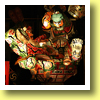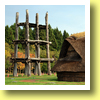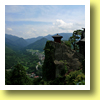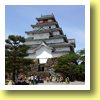Tohoku,
a region in the northernmost of Honshu
 Tohoku region is located in the north of Honshu, the largest island of Japan. Six prefectures - Aomori, Iwate, Miyagi, Akita, Yamagata, Fukushima are located in the region. There in the region are beautiful mountains, rivers and lakes as well as historic places including temples and castles.
Tohoku region is located in the north of Honshu, the largest island of Japan. Six prefectures - Aomori, Iwate, Miyagi, Akita, Yamagata, Fukushima are located in the region. There in the region are beautiful mountains, rivers and lakes as well as historic places including temples and castles.
Visitors, who walk Achi-Kochi in the region, would enjoy viewing various beautiful landscapes. In addition, the region, rich in nature, provides tourists with various tasty foods. In the region, the following places would be worth visiting.
Hirosaki
 Hirosaki is a city located in the west of Aomori Prefecture. The city used be the center of Hirosaki Feudal Domain ( or Tsugaru Domain ) through Tokugawa period ( the 17th-19th century ==> A History of Japan vol.2 Samurai Age ). There remains Hirosaki Castle surrounded by Buke Yashiki ( residences of samuirai families ) and old temples.
Hirosaki is a city located in the west of Aomori Prefecture. The city used be the center of Hirosaki Feudal Domain ( or Tsugaru Domain ) through Tokugawa period ( the 17th-19th century ==> A History of Japan vol.2 Samurai Age ). There remains Hirosaki Castle surrounded by Buke Yashiki ( residences of samuirai families ) and old temples.
Also the city has Neputa Festival ( a traditional festival ), Tsugaru Jamisen ( a traditional musical instrument ), Tsugaru-Nuri ( a traditional lacquerware ) and so on. There are many restaurants which serve traditional local specialty dishes.
Shirakami Sanchi
 Shirakami Sanchi, one of UNESCO World Heritage sites, is located in the southwest of Aomori Prefecture and in the northwest of Akita Prefecture. "Sanchi" in Japanese means a mountainous area. In Shirakami Sanchi, there remain primeval forests of beech trees, around which tourists could enjoy walking.
Shirakami Sanchi, one of UNESCO World Heritage sites, is located in the southwest of Aomori Prefecture and in the northwest of Akita Prefecture. "Sanchi" in Japanese means a mountainous area. In Shirakami Sanchi, there remain primeval forests of beech trees, around which tourists could enjoy walking.
It had been thought that beech trees were worthless economically. In addition, there had been no roads nor trails in most of the area. So beech tree forests remain as they were. Also tourists, walking in the forests, would enjoy viewing beautiful landscapes of lakes, waterfalls and streams.
Sannai-Maruyama Archaeological Site
 In Jomon Period ( B.C.14,000 - B.C. 1,000 ==> history vol.1 ), hunter-gatherers lived in Japanese archpelago. Sannai-Maruyama Archaeological Site, located in the southwest of Aomori City, contains the ruins of the largest Jomon settlement, where various Jomon structures ( right ) have been reconstructed.
In Jomon Period ( B.C.14,000 - B.C. 1,000 ==> history vol.1 ), hunter-gatherers lived in Japanese archpelago. Sannai-Maruyama Archaeological Site, located in the southwest of Aomori City, contains the ruins of the largest Jomon settlement, where various Jomon structures ( right ) have been reconstructed.
The site is one of designated Special National Historical Sites of Japan and is one of UNESCO World Cultural Heritage Sites. So many objects have been excavated at the site, among which almost 2,000 artifacts have collectively been designated one of Important Cultural Properties of Japan. A museum, located at the site, exhibits many excavated at the site. Sannai-Maruyama Archaeological Site and its museum are popular among tourists.
Oirase Gorge and Tsuta Onsen
 Oirase Gorge is famous for Oirase Stream ( right ) which flows out of Towada-Ko Lake. The walking trail ( length 14 km ), which runs along Oirase Stream, is so popular among tourists. Oirase Gorge, rich in nature, is a Special Place of Scenic Beauty and a Natural Monument of Japan.
Oirase Gorge is famous for Oirase Stream ( right ) which flows out of Towada-Ko Lake. The walking trail ( length 14 km ), which runs along Oirase Stream, is so popular among tourists. Oirase Gorge, rich in nature, is a Special Place of Scenic Beauty and a Natural Monument of Japan.
Tsuta Onsen hot spring, located near the entrance of Oirase Gorge, is also popular among tourists. A document written in the 12th century refers to Tsuta Onsen, where tourists could enjoy bathing in the old hot spring. There are lakes and ponds near Tsuta Onsen. A walking trail ( length 2.8km ) leads tourists to the lakes and ponds in the Japanese beech woods.
Yamadera ( Risshakuji Temple )
 Yamadera is a temple located in Yamagata city, Yamagata Prefecture, Tohoku region. Though its official name is "Risshakuji Temple", people call it "Yamadera". "Yama" in Japanese means "mountain" and "Dera" does "temple". Yes, "Yamadera" is a temple on a mountain.
Yamadera is a temple located in Yamagata city, Yamagata Prefecture, Tohoku region. Though its official name is "Risshakuji Temple", people call it "Yamadera". "Yama" in Japanese means "mountain" and "Dera" does "temple". Yes, "Yamadera" is a temple on a mountain.
Visitors, who climb up 1,015 stairs, would enjoy viewing landscapes from a unique temple on a mountain. It is said that the temple was founded in the 9th century. Basho Matsuo, a famous Haiku poet, visited the temple in A.D.1689.
Aizu Wakamatsu
 Aizu Wakamatsu City is located in the west of Fukushima Prefecture. The city has developed around the castle which was built in A.D.1384. Tsuru-ga Jo Castle was built in A.D.1593. The castle keep ( right ), demmorished in A.D.1874 in Meiji Period, was reconstruced in A.D.1965 in concrete.
Aizu Wakamatsu City is located in the west of Fukushima Prefecture. The city has developed around the castle which was built in A.D.1384. Tsuru-ga Jo Castle was built in A.D.1593. The castle keep ( right ), demmorished in A.D.1874 in Meiji Period, was reconstruced in A.D.1965 in concrete.
The culture and traditions have been and are handed over in the city for centuries since the samurai age. Visitors could see some remaining there. So Aizu Wakamatsu is called "Samurai City".
|